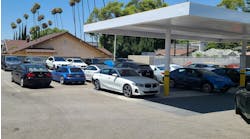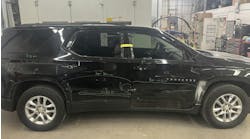specifications,
click here.(Adobe Acrobat Reader required)
Like all of today's Suzuki models, comfort and convenience features abound. Cup holders, storage compartments, power outlets and armrests are everywhere. Climate control and rear air conditioning are standard, and the standard audio system is ready for MP3, WMA and XM satellite radio. There are steering wheel controls for the audio system, but they're not really any more convenient to use than the dashboard dials.
Intermittent wipers and a tilt wheel also are standard, but the XL.7 has a flaw that we've noticed on many newer cars: The gauges are electronic and illuminated whenever the key is on. With daytime running lights, it's easy to forget to turn on the headlights at night, in which case there will be no rear lights.
Under the hood is the aforementioned V6 with belt-driven double overhead cam (DOHC) four-valve heads and a dual-tract intake manifold sporting a cable-operated throttle. The EGR valve and some of the major connectors are buried between the engine and firewall, but all the other service items and test ports are readily accessible.
Overall, the engine compartment is simple and tidy and gives the impression that, with proper service, the drivetrain should easily outlast the seven-year/100,000-mile warranty. While we had the vehicle, the Tire Pressure Monitor System (TPMS) warning light came on. None of the tires had the same pressure, but the maximum difference between them was only six psi. This is impressive performance for a system that uses wheel speed sensors instead of direct measurement. With all the tires inflated to 35 psi, ride and handling were noticeably improved.
On paper, the Suzuki is a mid-pack performer in its class. It's built on a full frame, so off-road and snow-belt performance will be better than car-based mini-SUVs, but there are other more powerful full-frame "trucklets" in this class, too.
The third row of seats is for small people only, but it's a feature most competitors don't have. Power is marginal, but the two-speed transfer case and advanced suspension are noticeable advantages. In the end, we think utility and good handling are this truck's strongest points.




